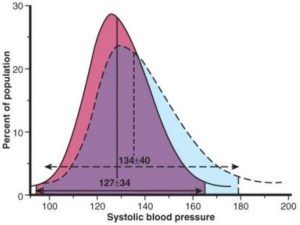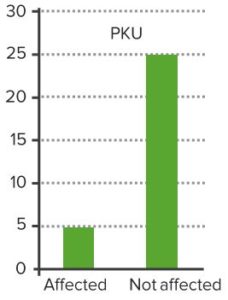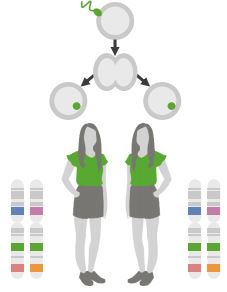Multifactorial Inheritance
Table of Contents

Image: “Karyotype color chromosomes white background.” License: Public Domain
Definitions
Phenotype is a feature or characteristic of an individual which can be either weighed, recorded or noticed e.g. hair or eye color.
Genotype is a part of the feature or phenotype which
is found in the progeny and is formed by alleles or gene located on
different loci. It is not possible to record/measure or notice a
genotype.
Polygenic inheritance is a mode of inheriting
phenotypic traits and occurs when several gene pairs located on
different loci have an additive effect leading to a particular trait or
characteristic of an individual e.g. the ridges on our fingertips.
Multifactorial inheritance is another mode of
inheritance which is polygenic, but is also due to influence of other
genes and the ante and post-natal environment of the individual. e.g.,
height and skin color of the individual.
Types of Phenotype Traits
They can be classified as qualitative, quantitative and threshold traits.

“Continuous Quantitative traits are measurable” Image created by Lecturio
Quantitative traits occur as a
result of continuous variation which is the sum total of small effects
caused by a gene. Usually, several genes or a group of genes control
quantitative traits. If multiple genes influence a trait, then it is
called a polygenic trait, e.g., height, human intelligence and skin
color. Height is considered the best example of a quantitative trait. It
occurs a range of values.
Qualitative traits are “yes or no traits” and can be
classified into categories which may not be in any particular order.
This type of trait has a monogenetic pattern of inheritance i.e. the
trait is only influenced by a single gene and the environment does not
play a role in the development of this trait.

“Discrete Qualitative traits are either present or absent” Image created by Lecturio
E.g. inherited disorders caused by a single gene mutation, ABO blood
groups. With a few rare exceptions, a majority of humans have one of the
following four categories of blood groups: A, B, AB or O. Since the ABO
blood group can be classified neatly into any of the four categories,
it is considered a good example of a qualitative trait.
Threshold traits are inherited quantitatively, but
are expressed qualitatively. As several genes form a threshold trait, it
is considered a quantitative trait in practice. Threshold traits occur
in families, but their exact segregation ratio cannot be predicted
unlike diseases inherited according to the Mendelian pattern.
Qualitative Traits: Risk Assessment
Risk of qualitative traits can be assessed using familial aggregation
studies like relative risk ratios and case control studies.
Relative risk ratios
Λr = presence of the disease in relatives/presence of the disease in the population.
If an allele increases the chance of developing a disease, then one
would expect the affected individual to have a greater than expected
number of affected relatives.
(Λr) = 1 means there is little or no genetic impact.
(Λr) > 1 means there is a possible genetic predisposition.
| Disease | Relationship | Λs |
| Schizophrenia | Siblings | 12 |
| Autism | Siblings | 150 |
| Bipolar disorder | Siblings | 7 |
| NIDDM (type I DM) | Siblings | 35 |
| Crohn’s disease | Siblings | 25 |
| Multiple sclerosis | Siblings | 24 |
Case control studies are another method to calculate
the risk. In this, the genetic contribution is evaluated by comparing
an affected individual to an unrelated control i.e. the spouse who has
shared the same environment.
Approximately 3.5% of the first degree relatives of patients with
multiple sclerosis (MS) are also reported to suffer from the disease,
indicating a genetic component to the disease. This can be compared to
an incidence of only 0.2% of first degree relative of matched controls
(married couples) who suffer from MS.
Considering the incidence of 3.5% and 0.2%, we can calculate that the
incidence of MS would be 18 times greater amongst siblings than amongst
unrelated individuals.
Quantitative Traits: Risk Assessment
The risk for quantitative traits can be assessed using correlation and heritability studies.
Correlation studies: The coefficient of correlation
(r) is a measure of similarities amongst relatives. A positive
correlation is represented by an upward slope, while the negative
correlation is represented by a straight line or downward slope.
Heritability studies (H2): Measures the
extent of variation in a phenotypic trait attributable to a genetic
variation (not environmental) amongst individuals of a population.
H2 = 1 (heritability equals one means that all variations are attributable to genetics)
H2 = 0 (none of the heritability is attributable to genetics or anywhere in between)
Twin studies

“Identical. Monozygotic twins share 100% of their genetic information (theoretically)” Image created by Lecturio
Theoretically, identical or monozygotic twins share almost 100% of
their genetic information with epigenetic studies providing more
detailed information about this observation.
Fraternal or dizygotic twins share approximately 50% of their genetic
information depending on whether they inherited maternal or paternal
traits.
Concordance values: If one twin has a trait, then
concordance value estimates the frequency of the other twin having it
too. Greater concordance in monozygotic twins versus dizygotic twins
provides evidence that there is a genetic component to the disease. From
the concordance values in the following list, one can discern that
there is likelihood of a genetic component in these conditions:
| Disorder | Monzygotic twins | Dizygotic twins |
| Multiple sclerosis | 18 | 2 |
| Schizophrenia | 46 | 15 |
| Bipolar disorder | 62 | 8 |
| Rheumatoid arthritis | 12 | 3 |
| Cleft lip w/wo cleft palate | 30 | 2 |
| Systemic lupus erythematosus | 22 | 0 |
Multifactorial Gene Disorders
Multifactorial gene disorders occur as a result of a combination of
several factors. These include genetic factors, as well as environmental
factors, which lead to small variations in the inherited genes. There
is a different “threshold” of expression so that one gender is more
adversely affected than the other. For example, congenital hip dysplasia
is more common amongst females than amongst males.
The probability of a multifactorial trait occurring in a family
depends upon how close the relationship is between the family member
with the trait and the rest of the family. For example, the incidence is
higher if a sibling has the trait compared to if a first cousin has the
trait as family members share a specific percentage of the genes based
on the relationship.
| Relationship degree | Percentage of common genes | Examples |
| 1st degree relative | 50% | Parents, children, siblings |
| 2nd degree relative | 25% | Aunts, uncles, nieces, nephews & grandchildren |
| 3rd degree relative | 12.5% | First cousins |
Examples of Multifactorial Gene Disorders
Multifactorial disorders without a clear genetic component
Multifactorial disorders without a clear genetic component are, for
example, congenital heart disorders (ventricular septal defect, patent
ductus arteriosus, atrial septal defect, and aortic stenosis),
neuropsychiatric disorders and coronary artery disease. Although the
exact genes responsible for the disorders are yet unknown, genome
studies are likely to reveal the details in the near future.
Congenital heart disorders:
| Defect | Incidence in the population | Frequency in siblings in % | Λr |
| Ventricular septal defect | 0.17 | 4.3 | 25 |
| Patent ductus arteriosus | 0.083 | 3.2 | 38 |
| Atrial septal defect | 0.060 | 3.2 | 48 |
| Aortic stenosis | 0.044 | 2.6 | 59 |
Table: Congenital heart disorders
The high relative risk ratio (lambda value) in the above table indicates a probable genetic component.
Schizophrenia: This is a neuropsychiatric multiple
personality disorder which affects approximately 1% of the population
with a concordance value of 40 – 60% in monozygotic twins and 10 – 16%
in dizygotic twins. This suggests that there is a strong genetic
component to the disorder.
Bipolar disorder: This disorder affects
approximately 0.8% of the population with twin and family aggregation
studies indicating a strong genetic component.
Coronary artery disease (CAD): Concordance rates in
monozygotic twin studies indicate a strong genetic component in CAD,
although non-genetic and environmental components (diet, physical
activities and smoking) can influence the development of this condition
too.
Neural tube defects (NTD): The incidence of NTDs,
spina bifida, and anencephaly are approximately 1 to 2 cases per 1,000
live births with females being affected more than males. They occur as a
result of inheritance of genes from both parents combined with
environmental factors such as uncontrolled maternal diabetes,
anti-epileptic medications prescribed to the mother etc.
A couple who have a child with NTD have a 3 – 5% probability of
having another child with the same disorder, although the type of NTD
may be different with that child. While the first child may have
anencephaly, the second may have spina bifida.
Congenital hip dysplasia (CHD): As mentioned
earlier, this is more common amongst females than males. Maternal
hormones are the environmental factor contributing to the development of
CHD. A couple who have a child with CHD have a 6% probability of having
another child with CHD.
Multifactorial disorders which most probably have a genetic contribution
Venous thrombosis: It is now known that there are
three factors involved in the development of idiopathic cerebral
thrombosis – two genetic factors and one environmental factor (oral
contraceptive pill). However, the genetic factors contributing to lower
limb thrombosis are not yet known.
Other examples include factor V mutation which increases incidence of
thrombosis and mutation in prothrombin which leads to accelerated clot
formation. Environmental factors like oral contraceptive pills, smoking
etc. individually increase the risk of thrombosis several fold and, when
combined with the genetic factors, can lead to an exponential increase
in the incidence of thrombosis.
Hirschsprung disease: This is a developmental
abnormality associated with an absence of enteric ganglia leading to
symptoms of constipation and intestinal obstruction. Miss-sense, loss of
function, mutation in the RET gene, as well as mutations in the
non-coding regulatory regions near the RET locus, are now known to cause
this condition.
Type I diabetes: It is now known to be an autoimmune
disorder with complex inheritance associated with Major
Histocompatibility Complex (MHC) genes on chromosome 6. Twin studies
have reported 40% concordance amongst monozygotic twins.
Alzheimer’s disease: With increasing lifespans, the
incidence of this condition is currently reported to be 1 – 2% of the
elderly. There are several forms of Alzheimer’s disease. Three autosomal
dominant forms result in the late onset of Alzheimer’s (>60 years of
age). Twin studies indicate concordance values of 50% in monozygotic
twins. Genetic studies have found that individuals with two copies of E 4
allele for the Apolipoprotein E have an early onset form of Alzheimer’s
disease.
Comentários
Enviar um comentário